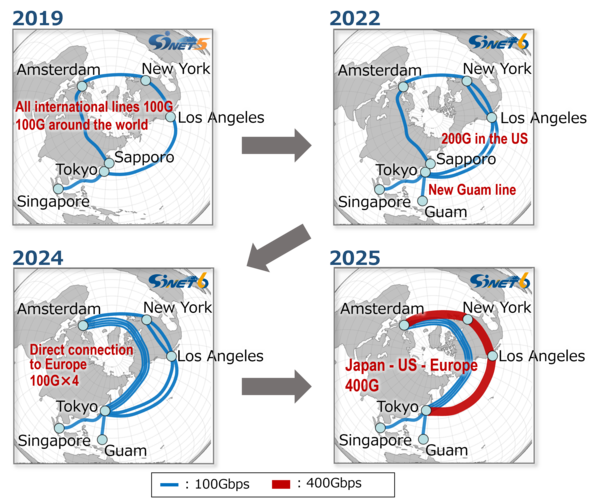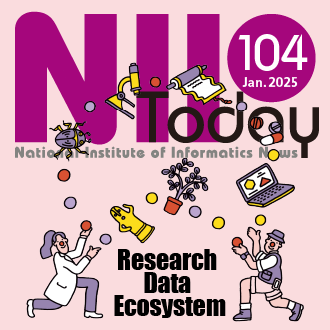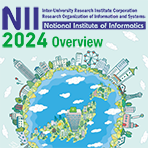News
News Release
Upgrade of International Communication Lines of the Science Information NETwork SINET6 - Ultra-high-speed network connecting Japan, the US, and Europe to reach 400 Gbps -
The Inter-University Research Institute Corporation Research Organization of Information and Systems, National Institute of Informatics (NII; Director-General: KUROHASHI Sadao; Chiyoda-ku, Tokyo) expanded the bandwidth of all international communication lines connecting Japan, the US, and Europe in the Science Information NETwork SINET6, to 400 Gbps. The upgraded network started operation in April 2025.
The international communication lines of SINET6 are being used for the ATLAS Experiment(*1) and the Belle II Experiment(*2) in high-energy physics research, and also for international collaboration in research projects in medicine and genetics. To support the large volume and constant stream of research data that occurs in such international collaborative research, international communication lines for science need more and more bandwidth and improved reliability.
The upgrade has resolved the congestion of international science communication lines that had been caused by the increased traffic, and has improved the stability of ultra-high-speed connections. By developing an environment that allows researchers around the world to share large volumes of research data quickly and reliably, we will contribute to further progress in international academic research.
1. Background of the international line upgrade
- SINET is a communication network used as scientific information infrastructure by universities and research institutes throughout Japan. It was built and is operated by the NII. Universities and research institutes across Japan are connected to SINET bases in their respective regions. With 400 Gbps ultra-high-speed lines, this communication network supports academic research in Japan.
- In 2019, the international lines of SINET became the first national research and education network in the world established by a single institution as a 100 Gbps academic network around the globe, connecting Japan, the US, and Europe(*3). Furthermore, in 2022, the lines in Asia were upgraded, and a 100 Gbps line between Japan and Guam was set up in addition to the one between Japan and Singapore. In April 2024, the connection to Europe was rerouted to pass through the US instead of Russia, and the line speed was increased to 400 Gbps. And now, in April 2025, the bandwidth in all communication lines connecting Japan, the US, and Europe was expanded to 400 Gbps (Table 1, Figure 1).
- We renew our international lines every two to three years and planned the upgrade to achieve faster and more stable data transmission in response to the increase in the data transfer volume accompanying the progress in academic research. In addition, as research networks in other countries were more and more equipped with 400 Gbps international lines, it had become necessary to prepare a network with an equivalent or faster speed to maintain Japan's research environment on an equal footing with the rest of the world.
2. Objectives of the international line upgrade
- With this upgrade, the speed of all routes connecting Japan, the US, and Europe was increased to 400 Gbps to further facilitate international cooperative research handling large volumes of research data, and to improve stability and speed. The upgrade realized the first 400 Gbps line in a science network in the Pacific region, and the line between Japan and Europe is the longest 400 Gbps line in a science network(*4).
- SINET connects large experimental facilities in Japan and overseas, supporting the constant transmission and reception of vast amounts of data. For example, SINET is connected to the world's most advanced large-scale research facilities, such as the Large Hadron Collider (LHC) and the experimental fusion reactor of ITER in Europe. For the rapid transfer of large-volume research data output from these experimental facilities, a stable broadband network is essential. Especially data from overseas experimental facilities can only be received smoothly if there is sufficient bandwidth. In recent years, the number of international collaborative projects spanning the US, Europe, and Asia has been increasing, and researchers have been demanding a broadband communication environment.
- As regards the US line, Belle II started full-scale operation in 2024, and in the Europe line, the data volume related to the LHC(*5) is expected to increase. For this reason, the construction of a new network using transmission technology of 400 Gbps or faster is underway mainly for communication lines in the US and Europe.
- The latest upgrade will enable stable, high-volume traffic between institutions, contributing to the development of academic research and education in Japan and around the world. For a stable operation like this, cooperation with overseas is also essential. Being linked over broadband connections, SINET and other science networks serve as foundations for a network of mutual backup, interoperability, and cooperation. In the unlikely event that a SINET connection is cut, another science network can be used as a backup, thus ensuring even more stable operations. To support data communications of academic research and educational institutions in various countries, national research and education networks (NRENs) specialized for use by universities and research institutions in their respective countries cooperate with NRENs of other countries in providing network infrastructure of high speed, large capacity, and stability. Together, NRENs in different countries have established an international science network, and strengthened ties with interconnected overseas research networks through collaboration.
| Line segment | From April 2019 | From April 2022 | From April 2024 | From April 2025 |
| Japan - Los Angeles | 100Gbps | 100Gbps × 2lines | 100Gbps × 2lines | 400Gbps |
| Los Angeles - New York | 100Gbps | 100Gbps × 2lines | 100Gbps × 2lines | 400Gbps |
| New York - Amsterdam | 100Gbps | 100Gbps | 100Gbps | 400Gbps |
| Japan - Amsterdam | 100Gbps | 100Gbps | 100Gbps × 4lines Change to pass through the US |
100Gbps × 4lines |
| Japan - Singapore | 100Gbps | 100Gbps | 100Gbps | 100Gbps |
| Japan - Guam | -- | 100Gbps | 100Gbps | 100Gbps |

3. Outlook for the future
- This upgrade will further strengthen our collaboration with international research networks. In particular, the improved connectivity with overseas research networks such as the Internet2 (US), GÉANT (Europe), SURFnet (Netherlands), and NORDUnet (Northern Europe) is expected to promote international joint research of Japan with the US, Europe, and Asia.
- The networks also serve as infrastructure to support cutting-edge technological research including quantum computing, AI, and big data analysis. We will promote further acceleration and stable operation of SINET's international lines also in the future, to contribute to the development of academic research and the global research environment.
- In addition, we will continue to promote research and development of next-generation network technologies and strengthen the infrastructure for a seamless connection of Japanese researchers with others in the world, thereby contributing to the development of science and technology in the future.

 Summary of NII 2024
Summary of NII 2024 NII Today No.104(EN)
NII Today No.104(EN) NII Today No.103(EN)
NII Today No.103(EN) Overview of NII 2024
Overview of NII 2024 Guidance of Informatics Program, SOKENDAI 24-25
Guidance of Informatics Program, SOKENDAI 24-25 NII Today No.102(EN)
NII Today No.102(EN) SINETStream Use Case: Mobile Animal Laboratory [Bio-Innovation Research Center, Tokushima Univ.]
SINETStream Use Case: Mobile Animal Laboratory [Bio-Innovation Research Center, Tokushima Univ.] The National Institute of Information Basic Principles of Respect for LGBTQ
The National Institute of Information Basic Principles of Respect for LGBTQ DAAD
DAAD
